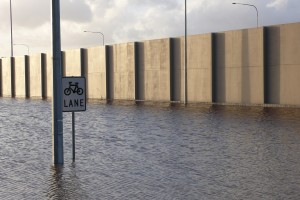
Climate change could cause more concentrated storms
Source: blogs.agu.org
By Nanci Bompey
A new study examining large, intense storms across Australia found that as temperatures increased, the same amount of rain from these storms was falling over smaller areas. The study’s authors found this to be consistent across all of the country’s climate zones, from temperate grasslands to tropical forests. These span nearly all of Earth’s climate zones and can be seen as a proxy for what is happening worldwide, according to the new research.Rising temperatures are causing heavy rain storms to become concentrated over smaller areas, a scenario that could potentially cause extreme flooding in urban locations, according to new research.
“Regardless of the total amount of rainfall, it is concentrated over smaller areas,” said Ashish Sharma, a professor in the school of civil and environmental engineering at the University of New South Wales in Sydney, Australia, and a co-author of the new study accepted for publication in Geophysical Research Letters, a journal of the American Geophysical Union.

A flooded road in Brisbane, Australia, in 2011. A new study shows rising temperatures are causing heavy rain storms to become concentrated over smaller areas, a scenario that could potentially cause extreme flooding in urban locations. Credit: Martin Howard/Flickr
The study’s authors attribute the change in storm area to a shift in the mix of cold and warm storms that has occurred as temperatures have increased. In general, cold storm events are more widespread over a geographic area, such as winter rainstorms that span a whole city. In contrast, warm storm events are more localized, such as summer rainstorms that might only pass through a few neighborhoods. As temperatures rise, there are more warm storm events concentrated in space and fewer cold storm events that are more widespread, Sharma said.
The study’s authors expect an increase in warm, concentrated storm events as temperatures continue to rise due to climate change. This could cause an increase in extreme flooding, especially in urban areas where current storm drainage infrastructure might not be able to cope with the heavy deluge of rain from these concentrated storms, Sharma said.
“It’s the civil engineering infrastructure that all of us take for granted,” he said. “Changing that infrastructure is not that easy because it is billions and billions of dollars that has already been put in place over years and years by different cities around the world, so modifying that to accommodate these increased floods is going to be a big challenge.”
“This is something that is inevitable, that we have brought unto ourselves, so I guess we now have to figure out how to handle it,” he added.
Can existing infrastructure hold up?
The new study grew out of a desire to understand if current flood infrastructure will be able to cope with changes in storms that are expected with warming temperatures. Previous work by Sharma and his co-author, Conrad Wasko, a graduate student in the school of civil and environmental engineering at the University of New South Wales, found rising temperatures are causing rain to fall for a shorter period of time across all of Australia’s climate zones.
This finding led the researchers to hypothesize that storms must also be decreasing in space, or becoming more concentrated in area. In the new study, the researchers, along with Seth Westra at the University of Adelaide, used precipitation data collected by the Australian Bureau of Meteorology dating back to the 1940s to calculate whether storms were shrinking in space.
They found big storms were becoming more concentrated in space, dumping rain over smaller areas, as temperatures rose. How much smaller or concentrated storms became depended on the climate – temperate areas saw more shrinking of the storm area compared to arid climates, the new study found. Although the extent of changes in storms varied by region, the decline in storm area was seen across all of Australia’s climate zones, Sharma said.
“The spatial and temporal changes that we have observed seem to be universal,” he said.
Sharma said a projected shift toward more concentrated storms in both space and time – essentially a “huge blob of rainfall” hitting an area – will increase flooding, especially in urban areas where there is nowhere for the rain to go and there are fewer factors, such as soil moisture, that can influence flooding.
Cities like Jakarta and Mumbai, which have experienced extreme flooding in recent years, have also become overpopulated. The combination of overpopulation and the changes in storm patterns will likely overwhelm urban storm infrastructure, Sharma said.
“I worry because they are having this double whammy: They are having this increased population which is more than what the system was designed to cope with and on top of it you are having these subtle changes in the climate extremes,” he said.
— Nanci Bompey is AGU’s public information manager.
